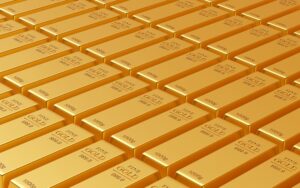
Precious metals showed the strongest performance among key asset classes in 2025 amid geopolitical tensions, expectations of a softening US Federal Reserve policy, and seasonally low liquidity at the end of the year.
According to market reports, silver rose 128.47%, gold rose 66.59%, and copper rose 35.45%.
US stock indices also ended the year in positive territory: the Nasdaq added 19.70% and the Russell 2000 added 12.53%.
At the same time, the crypto market showed weaker dynamics: Bitcoin fell by 5.75%, Ethereum by 11.58%, and the altcoin sector by 42.27%.
In the commodities market, the key driver was the “defensive” component of demand: gold hit new all-time highs in 2025, while silver showed relatively sharp growth; copper also strengthened amid bets on infrastructure and industrial demand.

On Wednesday, the price of gold on the spot market exceeded $4,500 per ounce for the first time in history, setting a new record.
By 8:31 a.m. Kyiv time, the spot price of gold had risen 0.1% to $4,490.56 per ounce, and earlier in the session it had risen to a record $4,525.77 per ounce. Futures on the Comex exchange also set a new historic high of $4,555.1 per ounce.
By 9:00 a.m. Kyiv time, these contracts had fallen back to $4,520.6 per ounce, which is 0.3% higher than the previous trading day.
Investors continue to buy gold as a safe-haven asset amid growing geopolitical tensions and expectations of further easing of the US Federal Reserve’s monetary policy amid a cooling labor market and slowing inflation. An additional factor is weak market liquidity at the end of the year, which exacerbates price volatility.
Earlier, the Experts Club analytical center presented an analysis of the world’s leading gold-producing countries in its video on YouTube channel — https://youtube.com/shorts/DWbzJ1e2tJc?si=BywddHO-JFWFqUFA

The price of gold on the spot market hit a record high for the 50th time since the beginning of the year due to expectations of a Fed rate cut and demand for safe-haven assets.
During trading on Tuesday, the spot price of gold rose 0.7% to $4,473 per ounce. The day before, gold rose at a record pace for the month, and since the beginning of the year, it has risen 70% and shown the best annual dynamics since 1979.
Other precious metals are also rising in price: the cost of silver increased by 0.2% to $69.2 per ounce, platinum by 1.3%, and palladium by 1%.
Market participants are monitoring events surrounding Venezuela. According to media reports, last weekend the US Coast Guard attempted to intercept another oil tanker allegedly linked to the country’s shadow fleet.
“Geopolitical tensions are back on the agenda,” said Ahmad Assiri of Pepperstone Group. “These events may not have caused an immediate reaction, but they certainly increase the demand for gold as a hedge against risk.”
In addition, investors believe that the Fed will continue to lower its key rate amid a weakening labor market. Low interest rates are a positive factor for gold prices, as they increase the relative attractiveness of investments in precious metals, which do not generate interest income.
Goldman Sachs analysts predict that in 2026, gold will rise to $4,900 per ounce in the base scenario.

According to Serbian Economist, Australian company Strickland Metals reported the discovery of rich gold-copper ores in the Šanac area of the Rogozna project in southern Serbia, potentially making this cluster one of the largest gold projects in the Balkans. The news was reported earlier by Australian business media.
According to the company, new drill results from the Šanac prospect indicate strong intervals of continuous gold and copper mineralization. The site is estimated to have a resource of about 165 tons of gold equivalent, and the combined potential of the entire Rogozna project is about 230 tons AuEq. A series of recent holes have shown extended intervals with gold grades well above initial expectations, including tens of meters of high grams-per-tonne equivalent.
A total of seven drill rigs are now active at Rogozna, including three at the equally prospective Gradina prospect, where over 700 meters of continuous gold and zinc mineralization was previously reported.
The Rogozna project is located in the Novi Pazar area, within the Tetian metallogenic belt, which hosts a number of large copper-gold deposits. According to Strickland’s corporate materials, the licensed area covers approximately 184 square kilometers and includes four exploration licenses; the resource is already estimated at millions of ounces of gold equivalent, placing Rogozna among the largest undeveloped gold projects in Europe.
Gold in the Serbian economy: production and reserves are growing
Serbia has been rapidly strengthening its position on the map of European gold mining in recent years. According to international statistical resources, the country’s gold production in 2023 was about 7 tons (7,000 kg), slightly lower than the record 7.29 tons in 2022, but many times higher than the average figures of the early 2000s.
The key industrial player is China’s Zijin Mining, which owns the Serbia Zijin Bor Copper complex and the Čukaru Peki deposit. In 2024, these assets jointly produced about 8 tons of gold as part of copper-gold mining, ensuring Serbia’s status as one of the fastest growing gold mining centers in the region.
In parallel, the National Bank of Serbia is actively building up its gold reserve. According to TradingEconomics and specialized industry surveys, the volume of the country’s official gold reserves has grown to 51 tons in the second-third quarter of 2025, compared to the average of 20-21 tons in the early 2000s.
Gold now accounts for about 17-18% of foreign exchange reserves, and Belgrade has been consistently repatriating the metal from foreign vaults back to the country.
Against the backdrop of growing production and increasing gold reserves, the Rogozna discoveries reinforce Serbia’s role as a promising hub for gold and base metals in Southeast Europe.
As the Rogozna resource base is refined and subsequent feasibility studies are conducted, the project could become one of the key arguments for further strengthening Serbia’s gold balance, but its realization, according to analysts, will require strict adherence to environmental standards and transparent agreements between investors, the state and local communities.

On Thursday, an official ceremony was held at the presidential administration in Bishkek, attended by the head of state, Sadyr Zhaparov. During the event, participants symbolically pressed the launch button, after which 50 million USDKG tokens were released into circulation on the Tron network, each of which corresponds to one US dollar and is fully backed by gold reserves.
According to the report, USDKG is designed as a transparent, secure, and stable digital currency that combines the reliability of gold with the efficiency of blockchain technology. The launch of the stablecoin should strengthen Kyrgyzstan’s position in the global financial ecosystem and lay the foundation for the development of Web3 infrastructure and decentralized services through which government agencies and businesses will be able to interact based on blockchain solutions.
The presidential administration notes that the new instrument is designed to increase the country’s investment attractiveness by creating conditions for capital inflows and technological partnerships. The authorities expect that the availability of a stablecoin backed by real assets will strengthen confidence in financial innovations and demonstrate the possibility of combining digital tools with material support in the interests of sustainable economic development.
The issuer of USDKG is JSC “Virtual Asset Issuer” with 100% state participation. The ceremony was attended by Kyrgyzstan’s Minister of Finance Almaz Baketaev and the company’s CEO Biibolot Mamitov, as well as representatives of the Gold Dollar project, who are involved in the technical and international aspects of the stablecoin’s implementation. In official materials, the project is positioned as the world’s first state-owned stablecoin backed by physical gold and pegged to the US dollar.

Gold prices are declining on Thursday amid the strengthening of the dollar before the publication of statistical data on the U.S. labor market. By 14:02 Q2 quotations of December gold futures on the Comex exchange fell by about 0.5% to $4061.5 per ounce.
The U.S. Department of Labor will release a report on the U.S. labor market for September at 15:30 Q2. The report is expected to show job growth of 50,000 and unemployment remaining at 4.3%, Trading Economics noted. It is published late due to the shutdown.
ICE’s DXY index, which shows the dollar’s performance against six currencies (euro, Swiss franc, yen, Canadian dollar, pound sterling and Swedish krona), added about 0.1%.
Meanwhile, analysts at UBS upgraded their forecast for gold to $4500 an ounce from $4200 an ounce by mid-2026. They believe that gold will be supported by the Federal Reserve’s easing monetary policy, as well as geopolitical uncertainty, increasing demand for protective assets.
Earlier, the Experts Club think tank presented an analysis of the world’s leading gold-producing countries in its video on Youtube channel – https://youtube.com/shorts/DWbzJ1e2tJc?si=YuRnDiu7jtfUPBR9.